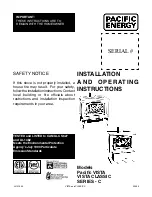
11
Chimney design
The chimney design is according to DIN EN 13384 - 2
or to the specific national regulations.
The chimney must comply with the temperature class
T400.
Necessary data
Closed operation:
●
Nominal thermal output ................................. 5,0 kW
● Waste air mass flow rate
............................... 4,3 g/s
●
Waste air temperature ................................... 275 °C
● Minimum delivery pressure at
nominal thermal output ....................................12 Pa
Combustion air supply
The Iriga Compact stove can be operated convention-
ally, dependent on the ambient air as well as independ-
ent of the ambient air.
It must be guaranteed that there is enough combustion
air available for the stove. For the proper function of the
stove, a necessary combustion air volume current of
15,6 m³/h must be considered.
Ambient air independent
combustion air connection
By an ambient air independent operating mode, the
combustion air must be added from outside through a
leak-proof line or through a supply duct in the chimney.
Thus, speak with your district chimney sweep master.
Due to energy saving reasons, the combustion air in-
let should be able to be blocked if the stove is not being
operated. This can occur through a shut-off valve in the
combustion air line or through the air slide valves on
the stove. If a shut-off valve is used, this must be clear-
ly identified with CLOSED/OPEN.
Through the shutoff, it is avoided that heat is removed
from the set-up room through the constant circulation
of cold combustion air and cold combustion air lines
may lead to an increased formation of condensation.
Attention:
The combustion air line may not be closed during
operation!
In order to feed the combustion air to the stove exter-
nally via a pipe instead of from the room in which it is in-
stalled, it is possible to screw a Ø 125 mm combustion
air pipe to the back of the stove or at the bottom. If the
combustion air pipe installed is longer than 3 m, calcu-
lations will have to be carried out to verify an adequate
supply of combustion air. At extremely low outdoor tem-
peratures, condensation can occur on the combustion
air duct. For this reason it must be insulated with a suit-
able insulating material. Observe the rules of the oven
and air heating construction craft.
Use the Olsberg combustion air pipes with sealing lip.
Installing the stove
The floor on which the stove is installed must be even
and horizontal. The stove may only be installed on an
adequate loadbearing floor. The stove can be stood
on a metal floor sheet or glass sheet to protect the
flooring.
If the flooring or carpet is inflammable, a stable, heat
proof spark protection plate must be used. This must
extend 50 cm to the front and 30 cm to each side be-
yond the edge of the combustion chamber opening.
Under the stove no spark protection plate is required.
Assembly sequence
●
The Ø 150 stovepipe connection can be installed at
the top or rear. The stove is supplied ready for con-
nection from above. If you wish to connect it at the
rear, the following steps must be carried out to make
the necessary modifications:
- Break out the cover in the back panel.
- Replace the connector sleeve and the sealing
cover.
●
Decide where the stove is to be installed. There
must be no objects made of combustible materials
within a distance of 80 cm of the stove’s radiation
area, measured from the combustion chamber’s in-
spection glass, nor may any be placed within this
area subsequently.
Minimum distance from combustible or load-
bearing walls:
lateral 18 cm and rear 30 cm
●
Install the pipe lining (provided on site) in the chim-
ney. The connection height can be individually spec-
ified for a top stovepipe connection, however should
not exceed 1.5 m from the connector sleeve. For the
rear stovepipe connection heights please refer the
“Technical Data“ chapter. No combustible material is
permitted within a radius of 20 cm around the stove
pipe.
●
Connect the stovepipe at both connection points
with stove putty so that the stove pipe is permanent-
ly sealed.
●
Push the stove onto its planned position and orient it
so that the stovepipe fits into the pipe lining.
The stovepipe connections must be tight. The
stovepipe must not protrude into the chimney.
Bear in mind that on partition walls in accordance
with test specification EN 13240 the temperature
of 85°C can be reached, and with light wallpaper
or similar combustible construction materials this
can result in colour changes.












































